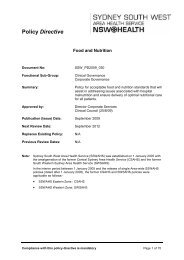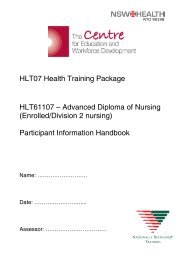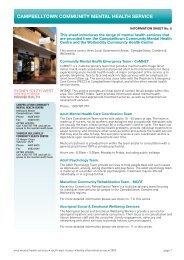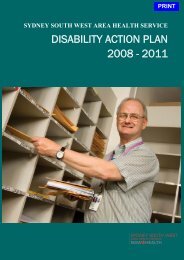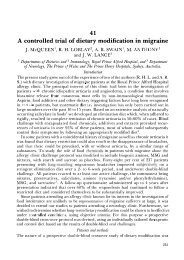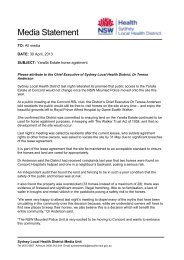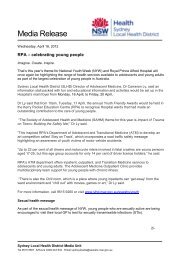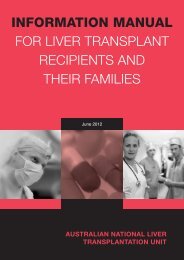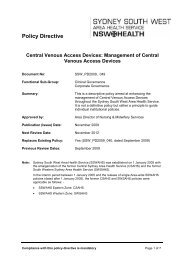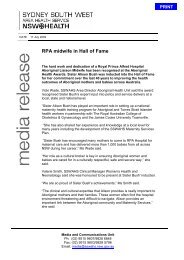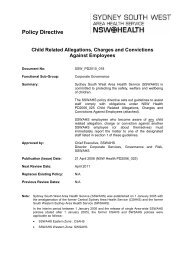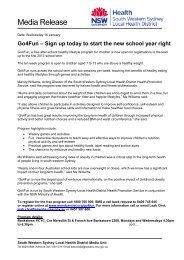Heparin and Warfarin - Sydney South West Area Health Service
Heparin and Warfarin - Sydney South West Area Health Service
Heparin and Warfarin - Sydney South West Area Health Service
Create successful ePaper yourself
Turn your PDF publications into a flip-book with our unique Google optimized e-Paper software.
<strong>Sydney</strong> <strong>South</strong> <strong>West</strong> <strong>Area</strong> <strong>Health</strong> <strong>Service</strong><br />
Guideline No: SSW_GL2007_010<br />
Date issued: November 2007<br />
1.3 Notes on Intravenous <strong>Heparin</strong><br />
1) A baseline full blood count, PT <strong>and</strong> aPTT should be performed prior to<br />
heparin therapy. A Haematologist should be consulted if there are<br />
significant baseline abnormalities.<br />
2) Full blood count should be performed at least three times per week, to<br />
exclude heparin induced thrombocytopaenia <strong>and</strong> a fall in haemoglobin to<br />
suggest bleeding.<br />
3) The possibility of a retroperitoneal bleed should be considered in the<br />
absence of another identified cause of pain in the back, leg, or abdomen.<br />
A full blood count should be performed <strong>and</strong> reviewed as soon as<br />
possible, as well as urgent medical assessment <strong>and</strong> imaging of the<br />
abdomen.<br />
4) Where the therapeutic intention is anticoagulation for venous<br />
thromboembolism, non-steroidal anti-inflammatory drugs (NSAIDs)<br />
should be ceased to reduce the risk of bleeding.<br />
5) In patients who have just had cardiac or great vessel surgery,<br />
consideration should be given to omitting the bolus dose of heparin. This<br />
should be discussed with the Cardiothoracic Surgeon.<br />
6) If the patient has had a recent surgical procedure, anticoagulation should<br />
be discussed with the Surgeon prior to initiation, where possible.<br />
1.4 Safety Issues with Infusion Pumps<br />
Care needs to be taken that pumps are operated according to hospital<br />
protocols <strong>and</strong> the manufacturer’s instructions. To reduce the risk of accidental<br />
infusion of a large volume of heparin solutions:<br />
1. When using a syringe pump; before removing the syringe from the pump,<br />
ensure that the clamp on the extension tubing is engaged to occlude flow.<br />
2. Ensure that pump settings are double checked by a second nurse<br />
regardless of whether a volumetric or a syringe pump is used.<br />
1.5 Changing Between Intravenous <strong>Heparin</strong> <strong>and</strong> Enoxaparin<br />
Where a decision is made to change the patient from intravenous heparin to<br />
Enoxaparin, the calculated dose of Enoxaparin (see low molecular weight<br />
heparin protocol) should usually be administered as soon as the intravenous<br />
<strong>Heparin</strong> is ceased, assuming the patient was not over-anticoagulated on<br />
<strong>Heparin</strong> at the time.<br />
If the patient were changed from subcutaneous Enoxaparin to intravenous<br />
<strong>Heparin</strong>, intravenous <strong>Heparin</strong> would normally be commenced when the next<br />
dose of Enoxaparin is due, assuming the patient was not over-anticoagulated<br />
at the time.<br />
2. Low Molecular Weight <strong>Heparin</strong> (Thromboembolism <strong>and</strong> Unstable<br />
Coronary Artery Syndromes)<br />
2.1 Products <strong>and</strong> Availability<br />
Enoxaparin (Clexane) is the preferred low molecular weight heparin (LMWH) in<br />
these guidelines. Dalteparin (Fragmin) may be alternatively used where it is the<br />
Compliance with this guideline is recommended Page 5 of 24




